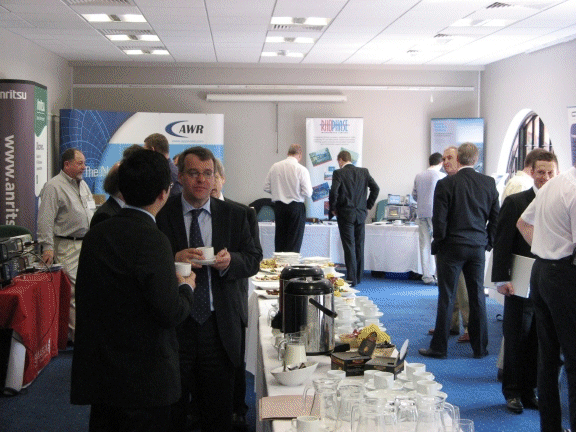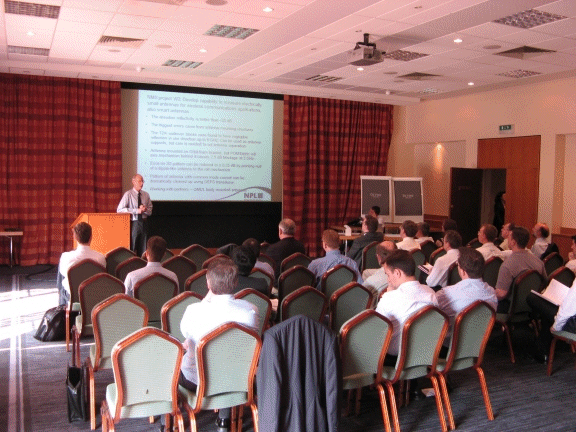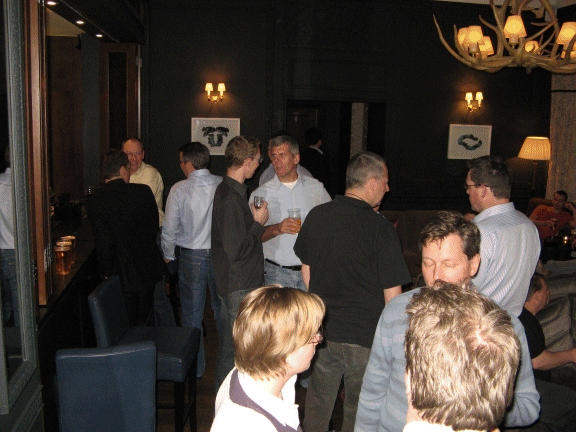 |  |  |
Milton Hill House
Steventon
Oxfordshire
OX13 6AF
| Tel | 0870 609 1153 |
| Web | www.devere.co.uk/venues/Milton-Hill-House/ |
John Crute
The Technology Academy
| Tel | 07974 172 914 |
| john.crute@thetechnologyacademy.com |
“On the fly” PA Design with the R&S NMDG ZVxPlus | |
| Guillaume Pailloncy | |
| Rohde & Schwarz | |
| In cooperation with NMDG, a world-wide recognized expert in nonlinear network analysis, R&S offers the ZVxPlus add-on kit on top of the high performance R&S ZVA or ZVT vector network analysers. This kit extends the network analysers to accurately characterise nonlinear RF and HF components in the time and frequency domain. The presentation shows how engineers can gain complete insight in their components to optimise their performance factors using such a measurement system. With the combination of a vector network analyser and the proper tuning techniques, amplifier designers can now, on the fly, visualise the behaviour of their circuits, optimise their performance based on time-domain measurements and study the impact of changing terminations, caused by, for example, antenna mismatch. | |
| “On the fly” PA Design with the R&S NMDG ZVxPlus | |
A New Frequency Synthesiser for Commercial Satellite Communications in Ku Band | |
| David Williams | |
| Teledyne Microwave | |
| The INTELSAT IESS standards for commercial satellite communications equipment define the frequency accuracy, channel allocations and spectral purity requirements for Earth Station Transmitters. Earth station transmission equipment commonly makes use of single or dual frequency conversion processes with a Frequency Synthesiser providing the final Local Oscillator tuneable in steps of 1 kHz. Historically, Frequency Synthesisers of this type were designed with multiple Phase Locked Loops often using the 'Mix and Divide' process. This paper describes a new Frequency Synthesiser design using a single microwave PLL which includes a 'Compound Phase Detector' (Patent Pending). | |
| A New Frequency Synthesiser for Commercial Satellite Communications in Ku Band | |
Applying the Feature Selective Validation (FSV) method to quantifying RF measurement comparisons. | |
| H.G. Sasse, A.P. Duffy, A. Orlandi | |
| De Montford University | |
| The FSV method was initially developed to provide an objective quantification of the data typical to the validation of computational electromagnetics in EMC applications. FSV has subsequently been embodied in IEEE Standard 1597.1: Standard for Validation of Computational Electromagnetics Computer Modeling and Simulations. The purpose of FSV is to provide a range of numerical and 'natural language' outputs from a global 'goodness of fit' value to a point by point analysis of the quality of the data comparison. From this, improvements can be quantified and areas that need to be addressed identified. The data to be compared often involves measured data. Hence, FSV can be applied to comparing measured data alone. The purpose of such comparisons include repeatability tests, aging analysis, 'portability' between facilities and assessing variations due to configuration changes. This paper presents the background to FSV, demonstrating that it compares favourably with the consolidated opinions of groups of engineers (in validation tests) and detail of its implementation. Through a series of data comparisons obtained from reverberation chamber tests, the interpretation of FSV results will be presented: showing the range of outputs from a single 'natural language' summary to a point-by-point analysis. | |
| Applying the Feature Selective Validation (FSV) method to quantifying RF measurement comparisons. | |
Behavioral Modeling of Digital Pre-Distortion Amplifier Systems | |
| Timothy Reeves | |
| The Mathworks | |
| With time to market pressures in the wireless telecomm industry shortened designed cycles are of the essence. One of the most intensive components to design in the wireless telecomm realm is the power amplifier assembly. This is a multi-discipline design challenge that incorporates both digital and analog design into the same assembly. In order to meet these design timelines, accurate high level behavioral models that can serve as the amplifier assemblies? ?executable specification? need to be developed at the commencement of the design cycle. Herein a methodology is presented that begins with a high level behavioral model of an RF amplifier and then incorporates this RF amplifier into a Digital Pre-Distortion (DPD) algorithm. Key performance characteristics such as Error Vector Magnitude (EVM) and Adjacent Channel Leakage Ratio (ACLR) are characterized. Finally, the digital pre-distortion approach is incorporated into a communications system that is based on IEEE 802.16-2004 and key system performance parameters such as bit error rate (BER) are evaluated for different signal to noise ratio (EbNo) values. | |
| Behavioral Modeling of Digital Pre-Distortion Amplifier Systems | |
Characterisation of Low Reflectivity Antenna Supports for Electrically Small Antennas, and Pattern Measurement via Optical Fibre to Eliminate Common Mode Current errors Common Mode Current Errors | |
| Martin Alexander, George Palikaras*, Yang Hao* and Marie Rajab* | |
| National Physical Laboratory and *Queen Mary University of London | |
| Electrically small antennas are widely used in wireless communications applications because they have near omni-directional radiation. Development of wearable computer systems has been growing rapidly: electrically, as well as physically, small antennas are important requirements to the successful deployment in the consumer market. It is undesirable to use bulky cables to connect to these wearable-mobile devices, so communication will be wireless, using an antenna. The biggest measurement challenge is to minimise reflections from antenna supports and feed cables. For reasons of space or cost small antennas may not have adequate baluns, and this can result in common mode currents flowing on any cable attached to them. These currents form an integral part of the antenna’s radiation pattern. One solution to avoid the problem with test cables is to replace the cable by optical fibre which connects to the antenna via an electro-optic transducer. A breakthrough reported in this paper is the development of a miniature electro-optic transducer. This system transfers the same information to a vector network analyser that a cable would but with the advantage that it can dramatically clean up the radiation pattern. | |
| Characterisation of Low Reflectivity Antenna Supports for Electrically Small Antennas, and Pattern Measurement via Optical Fibre to Eliminate Common Mode Current errors Common Mode Current Errors | |
Grounding Concepts in EM Simulators - What the Signal Integrity Engineer Needs to Know | |
| Malcolm Edwards | |
| Applied Wave Research Ltd | |
| Many modern simulators now support the notion of local grounding, where different ports can use different ground definitions. This paper shows how this flexibility in selecting ground can help the engineer characterize board, package, and interconnect performance. Several specific examples at the board, package, and chip level are discussed. | |
Optimum Design of a Probe Fed Dual Frequency Patch Antenna Using Genetic Algorithm | |
| Q. Lu, E. Korolkiewicz, S. Danaher, Z. Ghassemlooy and A. Sambell | |
| University of Northumbria | |
| Recent research has concentrated on different designs in order to increase the bandwidth of patch antennas and thus improve functionality of wireless communication systems. An alternative approach as shown in this paper is to design a matched probe fed rectangular patch antenna which can operate at both dual frequency (1.9 GHz and 2.4 GHz) and dual polarisation. In this design there are four variables, the two dimensions of the rectangular patch, ‘a’ and ‘b’ and position of the probe feed ‘Xp’ and ‘YP’. As there is not a unique solution Genetic Algorithm (GA) was applied using two objective functions for the return loss at each frequency. The antenna was then modelled using AWR software and the predicted and practical results are shown to be in good agreement. | |
| Optimum Design of a Probe Fed Dual Frequency Patch Antenna Using Genetic Algorithm | |
Surface Waves: What are they? Why are they interesting? | |
| J. Hendry | |
| Roke Manor Research | |
| Surface waves have been known about for many decades and quite in-depth research took place up until ~1960s and then very little work has been done on them. It is unclear why, however today we have more powerful modelling methods which may enable us to understand their use better. It is known that HF surface waves follow the terrain and this has been utilised in some cases such as Raytheon's HF surface wave (HFSW) radar for detecting ships. It is thought with some more insight and knowledge of this phenomenon, surface waves could be extremely useful for both military and civil use, from communications to agriculture. This paper will briefly outline what a surface waves are and why they are such an interesting phenomenon including potential applications. | |
| Surface Waves: What are they? Why are they interesting? | |
Systems for RF Interference Supression in a Jamming Environment | |
| Steve Nightingale | |
| ERA Technology Ltd | |
| This paper will describe two approaches for interference suppression: interference cancellation and interference nulling. Both techniques are mathematicllay related, but their physical realisations are quite different. The first is where a strong signal from a co-sited or close transmitter antenna couples to an antenna connected to a receiver operating in the same frequency band causing the receiver to become desensitised. The basic technique is to inject an exact antiphase version of the interfering signal into the receiver feeder to cancel it. This technique has been well proven for interfering narrowband radio signals, but this presentation will describe recent work dealing with broadband jamming signals, which overlap the desired receive channel. Communications through jamming measurements show that the original SINAD of the receiver can be nearly completely restored. The second system is where an n element antenna array, with a receiver behind each element, is used to provide n digital output signals which are then processed to simulate an antenna pattern with n-1 nulls in the direction of jamming signals and gain maxima in the direction of the desired signals. Frequency excision is also applied to remove simple narrowband jamming signals. This approach has been successfully applied to the design of anti-jam GPS systems for signals at the L1 (1575.42 MHz) and L2 (1227.60 MHz) frequencies. | |
| Systems for RF Interference Supression in a Jamming Environment | |
The Design of a Ka-Band Multiport Amplifier for Space Applications | |
| Robert Bridger, Gary Cobb, Peter James, John Crute* and John Lowdell | |
| Astrium Ltd and *The Technology Academy Ltd | |
| Unfortunately this paper has been withdrawn. | |
Transit Case to Transverse Waves, a Low Cost Anechoic Chamber | |
| Louise Foote, Kevin Maynard, Keith Clark & Peter Garner | |
| Surrey Satellite Technology Ltd | |
| This paper shows how a compact anechoic chamber with Electro Magnetic Compatibility (EMC) shielding, constructed by Surrey Satellite Technology (SSTL), for the testing of its satellite antennas has alleviated the need to rely upon external and expensive anechoic test house facilities. This novel low-cost system has allowed SSTL to accurately and repeatedly test a range of different production antennas including L-Band and S-Band patch antennas, X-Band horn antennas for current satellite missions and the development of X-Band patch antennas for future missions in an environment that is immune from reflections caused by surrounding objects in a typical laboratory. The flexibility of the system has also allowed it to be used to test whole global positioning system (GPS) and communications receiver modules in a ‘quiet’ environment. | |
| Transit Case to Transverse Waves, a Low Cost Anechoic Chamber | |
As usual a small exhibition accompanied the conference. For more information about exhibiting at ARMMS meetings please email: exhibition@armms.org
Contributions are invited with an emphasis on RF and microwave design, research, testing and associated subjects. An oral presentation will be made at the meeting and a written paper will be required for publication in the society digest, which is distributed to delegates at the meeting. Prospective speakers are requested to submit a title and a short abstract to the technical coordinator (see above) as soon as possible.
Click here to view our Guidelines for Authors
Click here to view our Publication Release Form